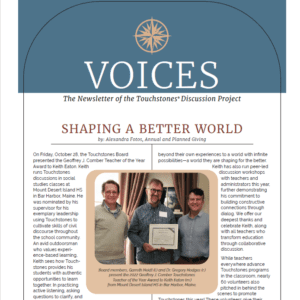“How Do We Grade Touchstones?”
By Sharon Thomas, Direction of K-12 and Family Engagement Programs
For all of the joys that come with teaching—helping students to learn, spirit week, supporting your community, frolicking outside with students on field day—one daily, required element of the job remains nearly universally unpopular: grading. Even with all the changes that have occurred in education over the last half century, grading has changed very little, especially in its relentlessness.
Teachers are typically required to have a specific number of grades in the gradebook for each course by each interim marking period, each final marking period, and then exam grades and final grades. Teachers are expected to include a minimum number of comments as part of their grades as well. Electronic gradebooks brought about greater ease in grade calculation and communication, and they also brought about increased and more frequent scrutiny of a teacher’s grades by both school leaders and families. Seeing administrators tracking down teachers to tell them to add more grades, to be sure to add that one missing comment, and to call so-and-so’s parent about that grade before they see it online is commonplace throughout the academic year.
Grading (the explicit assessment and quantification of learning) is necessary for data-driven instruction and for effective communication about student progress. It’s also stressful and exhausting.
No wonder then that one of teachers’ first questions when they begin implementing Touchstones is, “How do we grade it?”. Touchstones asks a teacher to dedicate approximately an hour of instructional time each week for their discussion lessons, and teachers know that means they need to grade that in some way to have enough of the required grades by the time report cards come around. We get it, and we’re here to help.
The Trouble with Traditional Discussion Grading Practices
We are with you, teachers: we want you to provide a grade for Touchstones in the gradebook, and just as Touchstones asks teachers to approach classroom discussion in a new way, fair and accurate assessment of Touchstones progress means understanding how traditional discussion grading practices are not helpful for teachers or students.
Like gradebooks overall, typical grading practices for classroom discussion look much like they always have, and that’s a problem. In discussion, that problem takes three forms:
- Too much focus on speaking: For generations, most teachers have graded students based on how many comments they make during a discussion. They don’t typically attach a grade to listening because they can’t “see” it. Listening is not as visibly evident to teachers as speaking is, even though listening is just as critical to good discussion as speaking is. Grading only speaking values people who speak frequently but not people who listen well.
- Too much focus on “right” answers to text: Traditional discussion grading often values students who provide the “right” answers on a topic that has been determined by the teacher. Students who speak may receive a lower grade (or no grade at all) if they bring in their own ideas, if they don’t use a specific text example, etc. In this paradigm, the teacher has unwittingly set up students to be motivated to “get the grade,” not motivated to engage with each other collaboratively. This approach keeps the discussion focused on the teacher’s agenda. Students thus focus on teacher-pleasing behaviors, not on how to discuss issues with each other any more fully or equitably.
- Too much focus on the dominators: With traditional grading practices, students who tend to dominate discussion are consistently rewarded for that behavior in the gradebook and continue to dominate, and quieter students receive the unintended but clear message that they are not valued, and there is no room for their voices. They thus remain quiet, sometimes for the duration of the year’s discussions. Teachers are frustrated by those silent students and typically don’t realize that ongoing silence is a result of the environment that they’re in, not of simple shyness or defiance. These behaviors of dominance and silence continue into all kinds of contexts in people’s lives. Have you ever wondered where the behaviors on caustic political talk shows began in allowing dominators to shout down calmer (and often more reasonable and collaborative) participants? Those behaviors began when they were children.
Traditional grading makes teachers feel as if they are encouraging more people to speak, a greater understanding of discourse, and more lively discussions. In reality, those practices inadvertently encourage less listening, they stunt the development of authentic dialogue, and they foster environments where some students know they have most of the power and other students know they have none.
Better Grading
How can we grade discussion more accurately, effectively, and helpfully for both teachers and students? The first step is to view participation holistically to include speaking, listening, reflecting on self and group progress, and demonstrating leadership by encouraging other voices and focusing on group needs.
How do we measure all that knowing that some pieces of that are harder to gauge than others? First, teachers can use the six steps of the Touchstones lesson plan to help them. We measure “participation” not just according to who speaks in whole group discussion but according to participation in all six areas:
- Ground Rules: Note signs of students’ attention.
- Read the Text: Note signs of students’ attention.
- Independent Work: Observe students as they complete the individual work and share their responses.
- Small Group Work: Walk around and observe participation in the groups and how students are engaging with each other.
- Whole Group Discussion: Note not how many times students speak but instead focus on who makes eye contact with the speaker, who encourages others to speak or makes space for others to speak, and other signs of showing responsibility for the group’s progress. Look for signs of listening, such as when students referencing each other’s comments from individual and small group work.
- Evaluation: Whether the evaluation occurs in verbal or written form, note the goals students set for themselves and for the group. Note signs of their listening by the specificity and accuracy of the issues they target, and the examples they provide. Teachers can also note how students provide feedback – constructively, objectively, positively, kindly, specifically, and so on.
Typically, students demonstrate a high level of participation and engagement in all parts of the lesson plan except for whole group discussion, at least at first. Whole group discussion is approximately 15 minutes of a 45-minute lesson plan and is naturally anxiety producing for most people, yet it’s often the only part of the lesson that teachers grade. We want to give credit where credit is due and to measure student growth and participation more accurately.
Vary Discussion Grading Formats
Tallying up each of those 6 elements may seem like a lot, but teachers don’t need to grade every element in every discussion. One week, evaluation may involve having students write a self-reflection on their progress to date. How well students target specific issues facing the group and themselves can drive that grade. Another week, that evaluation may take verbal form, and the teacher can grade the quality and specificity of those comments. Still other weeks, the teacher may tally some element of a goal that students set for the group in a specify area of discussion (e.g., asking questions, encouraging new voices, etc.). The important thing is to value all elements of the lesson, all types of participatory behaviors.
Importantly, modeling holistic evaluation is helpful for students as well. For example, when evaluating a discussion overall, many people have a hard-and-fast litmus test for success that sets our teeth on edge: “Did 100% of the people speak during the whole group discussion?” At Touchstones, we view success as increasing and rotating numbers of speakers across multiple discussions, not as 100% participation in whole group each time. Having every person speak every time is compliance, not discussion, and it assumes that humans are equally engaged and have equal numbers of ideas and responses about every topic. That notion simply does not hold. Explaining these nuances of discussion when presenting your own evaluation of the discussion will help students become increasingly skilled in evaluating themselves and the group as whole.
…
There’s an old adage about data in the workplace: “What gets measured gets done.” If we continue to measure discussion the ways we always have, then discussions will continue the way they always have—with some students dominating, many remaining silent, and everyone quietly acquiescing to the teacher’s agenda. That mode has never taught students how to interact with each other in the job world, how to collaborate, or how to share leadership. Grading may not have changed much over the decades, but that change can start at the daily, classroom level. Show students what you value by grading the fullness of discussion and be open and explicit with your rubric. In that way, students know not just what they need for growth in discussion; they know their teacher sees the fullness of them as people.




 Join the
Join the
Even after over 30 years using Touchstones, I appreciate this blog post. Thank you. My own practice, especially for the past 8 years in my English class, is to move away from grades for the most part (ungrading) and more towards self-assessment, conferencing, and documentation of learning. Teaching students how to pay attention to their growth, document it, and use it to communicate insight into their growth is, at least according the John Hattie’s meta analysis, one of the biggest returns on investment of time and effort. Too, it helps students see that participation, while it can come in several forms, is a key indicator of growth. And growth, more than points or “quantification” (always, but especially in situations like Touchstones, a subjective measure) is what we ought to be teaching students to recognize and honor.
Thanks again for the frank and important post.